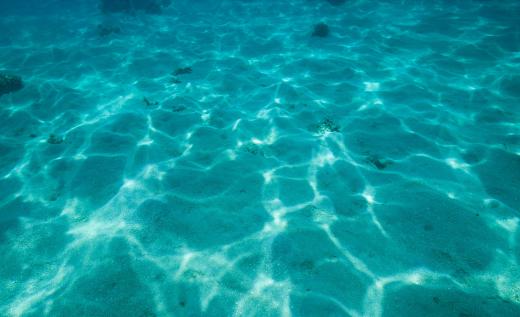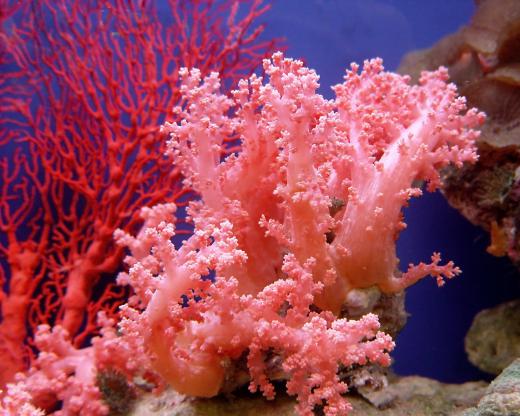What are Some Features of the Ocean Floor?
 Michael Anissimov
Michael Anissimov
The ocean floor off the continental shelf is known as the abyssal plain. The abyssal plain has a depth between 2,200 and 5,500 m (7,200 and 18,000 ft) and covers about 40% of the ocean floor. These areas are among the flattest and least explored on the Earth's surface. Less than one tenth of 1% of the abyssal plain has been explored by man, primarily using deep submarine robots.
The bottom of the ocean is flat because of sediments constantly building up there at an even rate. These sediments fall into three types: siliceous oozes (from silica shells), calcareous oozes (from calcite shells), and red clays (from windblown sand and micrometeorites). The sediments accumulate very slowly, just a few centimeters per millennium.

Life on the ocean floor is very sparse, making it similar to a vast desert. Marine organisms prefer shallow waters, where energy from photosynthesis is abundant, providing the foundation of the food chain. There are several oases on the ocean floor: hydrothermal vents, cold seeps, and whale falls. Hydrothermal vents release minerals rich in sulfides, which can be processed by chemotrophic bacteria acting as a keystone for small ecosystems. In cold seeps, a methane-filled brine leaks from cracks in the sea floor, also providing energy for bacteria. A whale fall is a whale carcass that falls from above. Because scavengers are so scarce on the ocean floor, it may take decades to centuries for a whale to be consumed. Scientists estimate the frequency of whale falls at approximately one every 25 km (15 mi).

The ocean floor is populated by bottom feeders that look somewhat like blobs. The blobfish, first discovered off the coast of Australia, is an example. Because of the extreme pressure, these fish have evolved a gelatinous texture of flesh with a density slightly less than sea water. This lets them float just above the surface without expending effort on swimming. Many bottom feeders have an underslung jaw, letting them scoop up nutrient-filled ooze from the ocean floor.
AS FEATURED ON:
AS FEATURED ON:













Discussion Comments
What are the special things about the Pacific floor?
What are the name of the features found on the bottom of the Indian Ocean?
the seafloor is surprisingly young because of the
mid ocean ridge. --jude
@ Anon31742- If you are asking about a cross section of the ocean floor, the top layers are the youngest. These layers are composed of marine sediment and can be very young. They can be only a few seconds old, as marine snow settles to the bottom. The deeper down you go, the older the sediment becomes, until it becomes sedimentary rock. Eventually, plate tectonics will force these sedimentary layers below another continental or ocean plate, or plate tectonics will force these sedimentary layers up out of the ocean.
@ Anon31742- The ocean floor near hot spots is also geologically young. Seamounts and mid ocean archipelagos are the youngest of these areas. These areas are formed when a magma chamber sits below a thin spot in the earth's crust, and the molten rock penetrates to the surface.
This creates very young layers of igneous rock, layers much younger than the surrounding sea floor. The Hawaiian Islands are some of the most well known of these hot spot formations. The archipelago actually runs almost 5000 miles to the north and northwest, almost to the edge of the pacific plate.
@ Anon31742- It depends on what part of the ocean floor you are talking about. The ocean floor near divergent plate boundaries is very young geologically. This is the area that plate tectonics is pulling the ocean apart, and magma is flowing to the surface. This would be the equivalent of a rift valley on land.
Convergent plate boundaries are often the oldest parts of the sea floor. This would be an area where one continental plate subducts below another. An example of this can be seen in the North Pacific Ocean floor near the Aleutian Islands into the Kamchatka Peninsula. The Aleutians are actually volcanic island arcs that form when the pacific plate subducts underneath the plate to the north (Arctic Plate??).
How old is the seafloor?
Post your comments